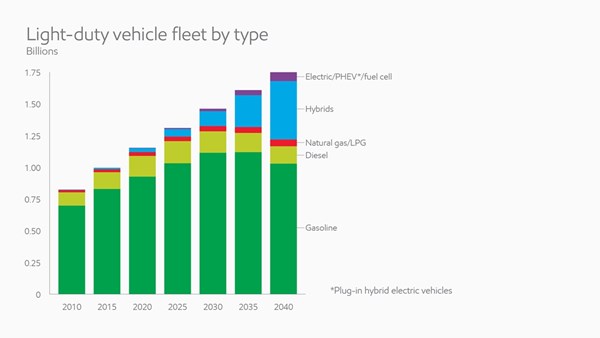Expanding Global Middle Class Equals Growing Energy Demand
There is a clear correlation between economic growth and energy use, or put more mathematicallyÔÇötotal people times higher living standards equals greater energy needs.
There is a clear correlation between economic growth and energy use, or put more mathematically—total people times higher living standards equals greater energy needs.
Larry Gros, ExxonMobil Chemical’s global polymer products and applications technology manager, shared those insights and more at injection molding machine and automation supplier Engel’s first ever North American Trend.Scaut Automotive event, held in Livonia, Mich., at the end of June (read more here and here).
Gros presented —an exhaustive review of what types of energy would see what level of demand from all over the world. From 2014 to 2040, the energy and chemical company sees global energy demand rising by 25%, noting that:
All the world’s energy sources will be needed to meet rising demand to 2040, but there will be a marked shift toward cleaner fuels, particularly natural gas.
While other energy sources make gains, Gros noted that oil will remain the top energy source for transport and for chemical production, with natural gas demand growing more than any other source.
Other key themes explored by Gros included the fact that energy is fundamental to living standards, and because of this, developing nations—which will lead in growth of GDP and living standards over the forecast window—will also lead in growth of energy demand over that time.
In the U.S., per capita energy consumption equates to 7 equivalent oil gallons per day, while globally, the average is only 1.7 gallons per day. “We will quickly see issues if rest of world grows into U.S. levels of consumption,” Gros noted, adding that, “as technology advances, it will improve efficiency and mitigate energy consumption growth.”
Developing World Develops
In 2014, more than half the world’s global GDP of $72 trillion could be attributed to advanced OECD countries, but the fastest growth rates were occurring outside those states, in nations like Turkey, Iran, Egypt, Saudi Arabia, and South Africa. ExxonMobil forecasts that by 2040, global GDP will more than double to $150 trillion, with all countries making gains, but the fastest rates experienced outside the OECD.
In fact, by 2040, Gros said developing countries will officially account for more than half of global GDP, with China and India expanding at rates of 5% and 5.5%, while the OECD at large grows at a rate of 2% over the forecast period. The greatest growth on a demographic basis, will occur within the middle class, which is forecast to more than double to five billion people by 2030, with the majority of that growth once again coming in India and China. By 2040, 85% of the world’s population will live in urban centers in OECD countries, as the globe adds the equivalent of 30 Chicago's during this period.
Efficiency Gains Allow OECD to Do More With Less
Even though overall energy demand will expand by 25% across the globe by 2040, it will be flat in OECD countries, as efficiency gains allow these countries to do more with less. Meanwhile, the 1.2 billion people without access to electricity today will finally start to join the global energy market. As they do, Gros said oil and gas will remain the world’s primary fuels through 2040, but sources of energy will shift. Particularly for coal, which will see its share of demand drop from 26% to 20%, while renewable sources, natural gas and nuclear grow.
Emissions to Flatten, Decline
In terms of emissions, Gros said ExxonMobil is predicting that global carbon dioxide output will peak at 2030, and begin to decline afterwards, with emissions falling 20% in OECD countries through 2040.
Fuel Standards Globalize
Transportation remains a key driver for energy demand, and Gros noted that the advent of stricter fuel standards globally will have a huge impact. “In 2008, only four countries had mandatory fuel economy standards, while some others had voluntary ones,” Gros said. “In 2014, many more adopted regulations, and now about 90% of light duty demand is in countries with standards or developing standards.”
Gros said global demand for light duty vehicles will peak in 2020, but added that there will not be fewer cars—with a global fleet of 1.7 billion by 2040—just that tomorrow’s cars will be more efficient (he also said China will surpass the U.S. in 2025 as the country with the most vehicles). Part of that efficiency will come from resins. Gros explained that without plastics, current vehicles would be about 10% heavier, adding that that 10% weight reduction leads to about a 7% improvement in fuel economy.
Instead of electric vehicles, Gros and ExxonMobil expect to see a big jump in hybrid vehicles, with those accounting for one quarter of the global fleet by 2040.

Related Content
BMW Group Vehicle to Adopt 3D Printed Center Console
A vehicle coming to market in 2027 will include a center console carrier manufactured through polymer robot-based large-format additive manufacturing (LFAM).
Read MoreImpacts of Auto’s Switch to Sustainability
Of all the trends you can see at NPE2024, this one is BIG. Not only is the auto industry transitioning to electrification but there are concerted efforts to modify the materials used, especially polymers, for interior applications.
Read MoreFor Extrusion and Injection-Blow Molders, Numerous Upgrades in Machines and Services
Uniloy is revising its machinery lines across the board and strengthening after-sales services in tooling maintenance, spare parts and tech service.
Read MoreFoam-Core Multilayer Blow Molding: How It’s Done
Learn here how to take advantage of new lightweighting and recycle utilization opportunities in consumer packaging, thanks to a collaboration of leaders in microcellular foaming and multilayer head design.
Read MoreRead Next
See Recyclers Close the Loop on Trade Show Production Scrap at NPE2024
A collaboration between show organizer PLASTICS, recycler CPR and size reduction experts WEIMA and Conair recovered and recycled all production scrap at NPE2024.
Read MoreFor PLASTICS' CEO Seaholm, NPE to Shine Light on Sustainability Successes
With advocacy, communication and sustainability as three main pillars, Seaholm leads a trade association to NPE that ‘is more active today than we have ever been.’
Read MoreMaking the Circular Economy a Reality
Driven by brand owner demands and new worldwide legislation, the entire supply chain is working toward the shift to circularity, with some evidence the circular economy has already begun.
Read More















